Amazon. com Delivers E-mail Subscriptions
Amazon. com: Please verify your new e-mail address – Fraud
At least one of the larger spam botnets is hard at work these last few days spreading itself via spoofed Amazon. com emails.
For the most part, these frauds do an excellent job of mimicking legitimate Amazon emails.
The arrive with a Subject line of:
From: “Amazon. com E-mail Subscriptions”
Subject: Amazon. com: Please verify your new e-mail address
And the design, layout and attention to detail within the email is quite good:
Click for Larger Image
The only real clues that these are not legitimate emails comes from:
Inspection of the Internet Delivery Headers which reveals that these emails are sent from previously infected personal computers throughout the world, and revealing a botnet of exceptional size. Reviewing the HTML code which makes it obvious that the “Confirm” button will not take you to an Amazon server but instead to any number of malware hosting servers, also spanning the globe.
Based on analysis of user feedback this campaign is highly convincing, and snaring many willing but unwitting victims.
OnlyMyEmail is an award winning hosted spam filtering service and business email hosting provider. Our enterprise cloud computing anti-spam solution, the MX-Defender, has the highest capture rate of any spam filter ever tested in the VBSpam Challenge, blocking a record setting 99.9993% of all malicious and junk email.
Our Personal spam filtering system is also a Software as a Service (SaaS) solution and has won both the PC World "World Class Award" and also the PC Magazine "Editor's Choice Award."
OME-Kids is a webmail solution that protects children from spam and other harmful emails. OME-Kids offers unique Parental Controls that allow you to choose the level of security and oversight that's right for your child.
This entry was posted on Tuesday, July 20th, 2010 at 7:43 am and is filed under Email Fraud, Spam Tactics. You can follow any responses to this entry through the RSS 2.0 feed. Both comments and pings are currently closed.
About AmazonLocal & Amazon Delivers E-mail Subscription
Receive regular updates on our best sales and deals, recommendations on new products (both bestselling and under-the-radar), gift ideas, and special features.
To manage your Amazon. com Delivers and Amazon Local e-mail subscriptions, go to Amazon Local and Amazon Delivers E-mail Subscriptions.
You can subscribe to any number of e-mail subscriptions depending on your interests, and these e-mails will be sent to the e-mail address associated with your Amazon. com account. Some subscriptions will be delivered on a regular schedule and show up in your mailbox on a weekly or monthly basis. Others will be sent only when an event of interest to you occurs.
Was this information helpful?
Thank you for your feedback.
Please select what best describes the information:
Thanks! While we're unable to respond directly to your feedback, we'll use this information to improve our online Help.
Contemporary Fiction

I adore stories of mothers and daughters. Especially when they explore that tough, tender space when a relationship grows beyond the simple (a woman caring for her young child) and into the complex—two adult women learning how to relate, how to communicate, how to walk through life together. Bonus points if it also includes some southern sass.
Imagine my delight, then, when I first read Liz Talley’s latest novel, Room to Breathe. Here are two women, mother Daphne and daughter Ellery, who are both on the cusp of new chapters in life. Ellery has graduated college and is, for the first time, experiencing disappointment when her dreams don’t start immediately coming true. Daphne, on the other hand, has shed a needy ex-husband, is excelling in a surprising new career, and is being flattered by the attentions of a man her daughter’s age.
In fact, he used to be her daughter’s boyfriend.
With exuberant charm and warmhearted humor (and a few shared bottles of wine), these two women come into their own, and come to appreciate and love one another in brand-new ways. This story is going to stay in my heart for a long time.
And on a personal note: Mom, I love you. And you’re gonna love this book.

What would you do if your child went missing? Would the pain and unspeakable heartache make you question everyone around you? When Susan and Paul Warner relocate to the country along with their two-year-old daughter, Amelia, they seem to have it all. But looks can be deceiving.
As they invite the new community to celebrate their arrival, the unthinkable happens—Amelia goes missing. As the desperate search for her begins, Susan and Paul’s relationship crumbles under the unthinkable agony. Paul becomes distant, and Susan seems numb. The way that they deal with their grief is seemingly in stark contrast, one looking backward, feeling distress and guilt, and one looking forward, filled with fear of all those around them. But as the plot unravels, you begin to realize that first appearances can be deceiving.
Intense and haunting, the story switches back and forth between the events that led to Susan first meeting Paul and the secrets that each of them share. Just when you begin to think you have a handle on this book, it delivers such a turnabout in direction it will give you whiplash.
Family Drama

Being a mother seems natural to so many women—but not all. When Charlotte McKay wakes up from a car accident and finds that she can’t remember the last few years of her life, the biggest surprise of all is not the few extra wrinkles or even the loss of her high-flying city job; it is the fact that she has a daughter—despite always being certain she never wanted a child. How has this happened? How is there a tiny person, completely reliant upon her, when Charlotte can’t even remember being pregnant?
The Puzzle of You brings into high relief the way an idea you might have of yourself can one day be unrecognizable from reality. I was so moved by Charlotte’s journey, as she learns to rethink everything she once held to be true, not least because of the strain it puts upon her once strong marriage.
And at the heart of this gripping novel lies the ultimate dilemma: Can Charlotte learn to love her daughter, or is the life she once had the one she wants now?

I have always been drawn to characters who don’t know when to give up. Nik Pohl is exactly that—a detective who will stop at nothing to catch a killer, even when that killer is trying to catch him too.
Darkness seeps through the pages of this gritty, thrilling mystery, and in this unflinching first entry in the series, Hartung introduces a protagonist to rival Jo Nesbø’s Harry Hole. After years on the job working every kind of case imaginable, Detective Pohl knows something is wrong. A young woman has disappeared, but with no sign of a crime. She left a letter for her parents, asking them not to look for her. It’s too clean. His suspicions are confirmed when he discovers a link to another woman who disappeared, leaving a similar letter behind before dying in a freak accident. But that’s not all that connects them: the women look almost identical.
Once it becomes clear that Pohl can trust no one, not even within his own police department, the mystery of what happened to these victims is impossible to resist. Like Pohl, I had to know why someone would cause such destruction, but I was stunned to see how far the debris could reach. In Hartung’s gripping conclusion, I finally realized how deep these shards can cut—and how some wounds, although shallow, bleed the longest.
Science Fiction

Is The Last Dance an Agatha Christie–style investigative mystery? A beautiful, slow-burning love story? A space opera featuring an unforgettable cast and a simple idea suggested to the author by none other than Apollo 11’s Buzz Aldrin? The answer is yes, and yes, and yes. It’s not often that I get to trumpet a novel that so imaginatively straddles genres, but Martin L. Shoemaker’s The Last Dance is that novel, and this is that clarion call.
The novel’s heroine is Inspector General Park Yerim—imagine a cross between Miss Marple and Robert Mueller—sent to an Earth–Mars merchant ship to investigate the alleged mutiny of Captain Nicolau Aames. As she takes testimony from the often uncooperative crew, she (and readers) begin to unravel the complex backstory of the captain and the events that led to Yerim’s assignment. Very little is as it seems, and it turns out that red herrings survive just as well in space as on Earth.
Author Martin L. Shoemaker’s short stories have been collected in several “Best of” anthologies, and he is one of those exceptional writers who understands that readers don’t limit themselves to specific genres, and neither should stories. A twists-and-turns mystery or a deeply impassioned romance, or both, are as much at home on a “Mars cycler” as in any terrestrial setting—even if the possibilities for dance are vastly expanded in one-quarter gravity.
Deliver the Mail with Amazon SES and Rails

Amazon Simple Email Service (Amazon SES) is a cost-effective email service built on the reliable and scalable infrastructure that Amazon. com developed to serve its own customer base. With Amazon SES, you can send transactional email, marketing messages, or any other type of high-quality content to your customers. You can also use Amazon SES to receive messages and deliver them to an Amazon S3 bucket, call your custom code via an AWS Lambda function, or publish notifications to Amazon SNS. With Amazon SES, you have no required minimum commitments – you pay as you go and only pay for what you use.
This post will walk you through quickly setting up a Rails app to send 62,000 free emails per month if you are sending from an Amazon EC2 instance (App deployed on Amazon EC2). Additionally, you can also receive 1,000 emails per month for free on Amazon SES. Even if you’re not on Amazon EC2 you can still get the cheapest ($0.10 per 1,000 emails) pricing available when hosted elsewhere (Heroku, DigitalOcean etc.). We’ll be sending emails from the Amazon SES Sandbox for this article, as moving out of the Sandbox requires requesting AWS support for extended access. Sending emails from the Sandbox has some limitations, like we have to verify both the sending and receiving email addresses. But we can test our setup by doing so and ensure that everything is setup properly with the right code is in place to send emails with extended access in Production.
Why Amazon SES?
It’s the cheapest. Although there are some limitations, like you can’t use dedicated IP addresses and the analytics are not as good as some of the other alternatives out there. But this is great option if you need to send a lot of email within a budget.
Price Comparison
Here is a quick comparison of SES pricing to some of the other well-known email providers.
Cost at 40,000 emails per month:
| AmazonSES | $4 |
| Mailgun | $15 |
| MailJet | $17 |
| Postmark | $30 |
| SendinBlue | $7.5 |
| SendGrid | $10 |
Getting Started
Let’s jump straight into coding to quickly set things up to send emails with our Rails app through Amazon SES. We’re not going to worry about a lot of the vanilla Rails setup, focusing on the intended feature which is to create a bare bone Rails application to send emails through Amazon SES.
I’m running Ruby 2.3.0 and Rails 4.2.6.
This will create a new Rails app. Change your directory to the newly created app:
Create a welcome controller with index action:
Go to the config/routes. rb file and remove all the commented out examples so that you get a clean routes file to work with. Define a get route, a post route and application root by adding these three lines:
The routes file should look something like this after adding the above three lines:
Add the send_email action to welcome_controller (app/controllers/welcome_controller. rb)
Let’s make a form on our application root for sending the emails. Before adding the form to the view file, add Twitter Bootstrap to have an shiny elegant email form. Add the Bootstrap-sass Gem to your Gemfile:
Run the bundle command to make sure the Gem is installed and picked up by our Rails app. You need to remove all contents from your app/assets/stylesheets/application. css file, rename it to application. scss, and add these two lines:
You’re good to go with Twitter Bootstrap, now paste this HTML in app/views/welcome/index. html. erb:
We won’t go into the details of this HTML, as it clearly is out of scope of our intended feature. But this is a super easy HTML form with some Twitter Bootstrap magic which gives us a nice email form.
Go to http://localhost:3000/ in the browser and you should a form like this:

Let’s generate a mailer for our Rails app:
This will add two files application_mailer. rb and my_mailer. rb in app/mailers directory, as well as two files mailer. html. erb and mailer. text. erb in app/views/layouts directory. Now add the send_email action to the empty app/mailers/my_mailer. rb file, which should look something like this:
After adding the send_email action to our mailer file, change the default From email address in app/mailers/application_mailer. rb file to the address you wish to use. In this tutorial, I’ll call it Some_email@example. com.
We can remove app/views/layouts/mailer. html. erb for now, as we will be sending plain Text emails for this tutorial. Create a new file in app/view/mailers/ named send_email. text. erb and add these lines :
This will be used as text template for our emails.
Open up config/environments/development. rb in order to change the SMTP configuration and test the emails out in the local development environment. Deploying this application to a Production environment is out of scope of this post. We’re just going to go through the Amazon SES setup, code and configuration to get our app ready to send 62,000 free email per month from an Amazon EC2 instance. There’s already a great in-depth tutorial on SitePoint which runs through deploying to EC2. In fact, I personally read that tutorial to deploy on Amazon EC2 with Capistrano.
Head over to the config/environments/development. rb and make these changes to get our app ready to send emails. First of all set action_mailer. perform_deliveries to true as it is set to false by default in the Development environment:
Next, look for this line:
And set it’s value to true. This will help debug delivery errors if our email fails to deliver for some reason.
Now paste the SMTP settings info the configuration block:
We have left Address out for later, which we will copy from the Amazon SES management console.
There’s a number of things we need to do now on our Amazon SES management console:
Login to AWS management console. Sign up for AWS if you haven’t already. It’s pretty simple.
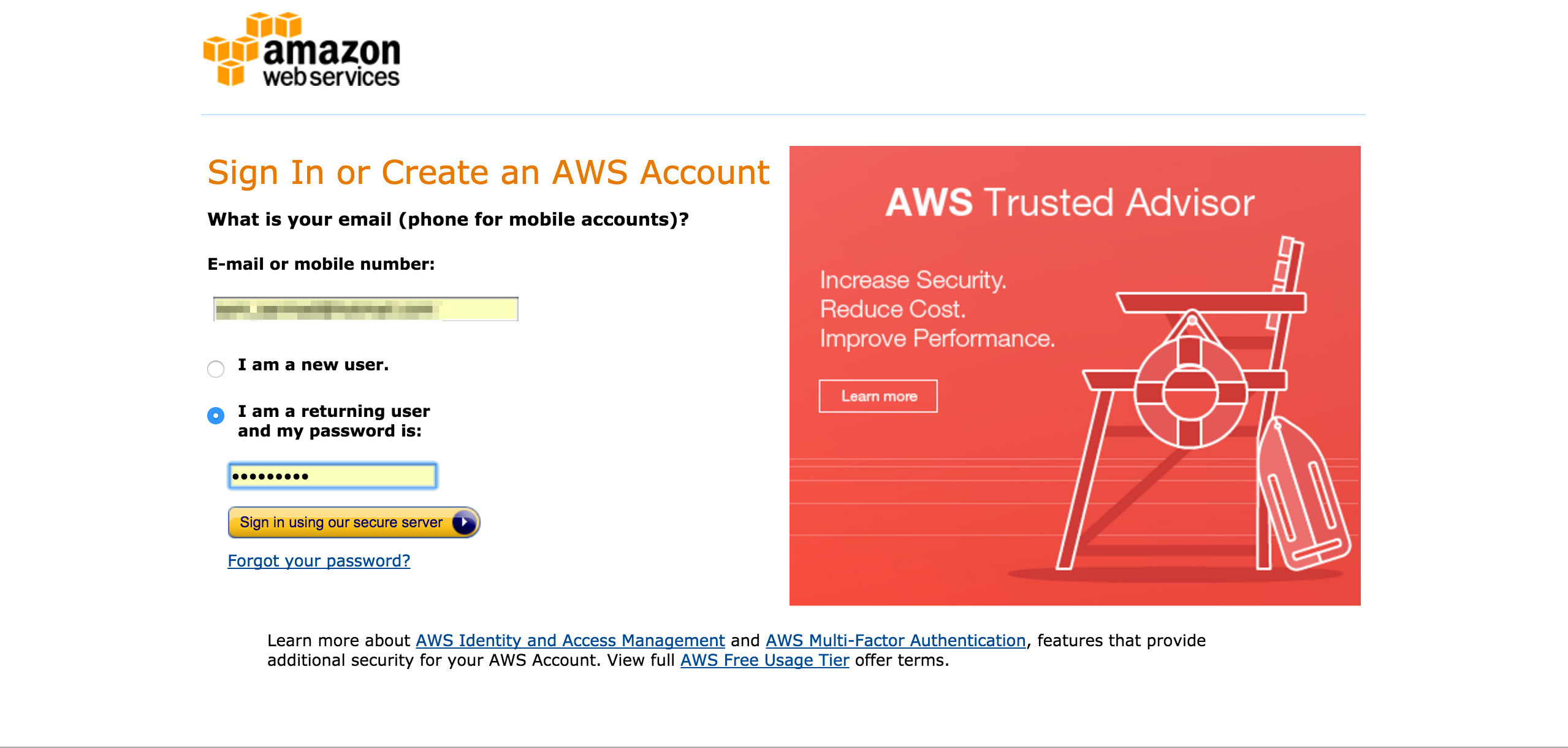
It will take you to the AWS Dashboard, look for SES.

Click on “SES” to go to the Amazon SES Dashboard. Click on “Email Addresses”
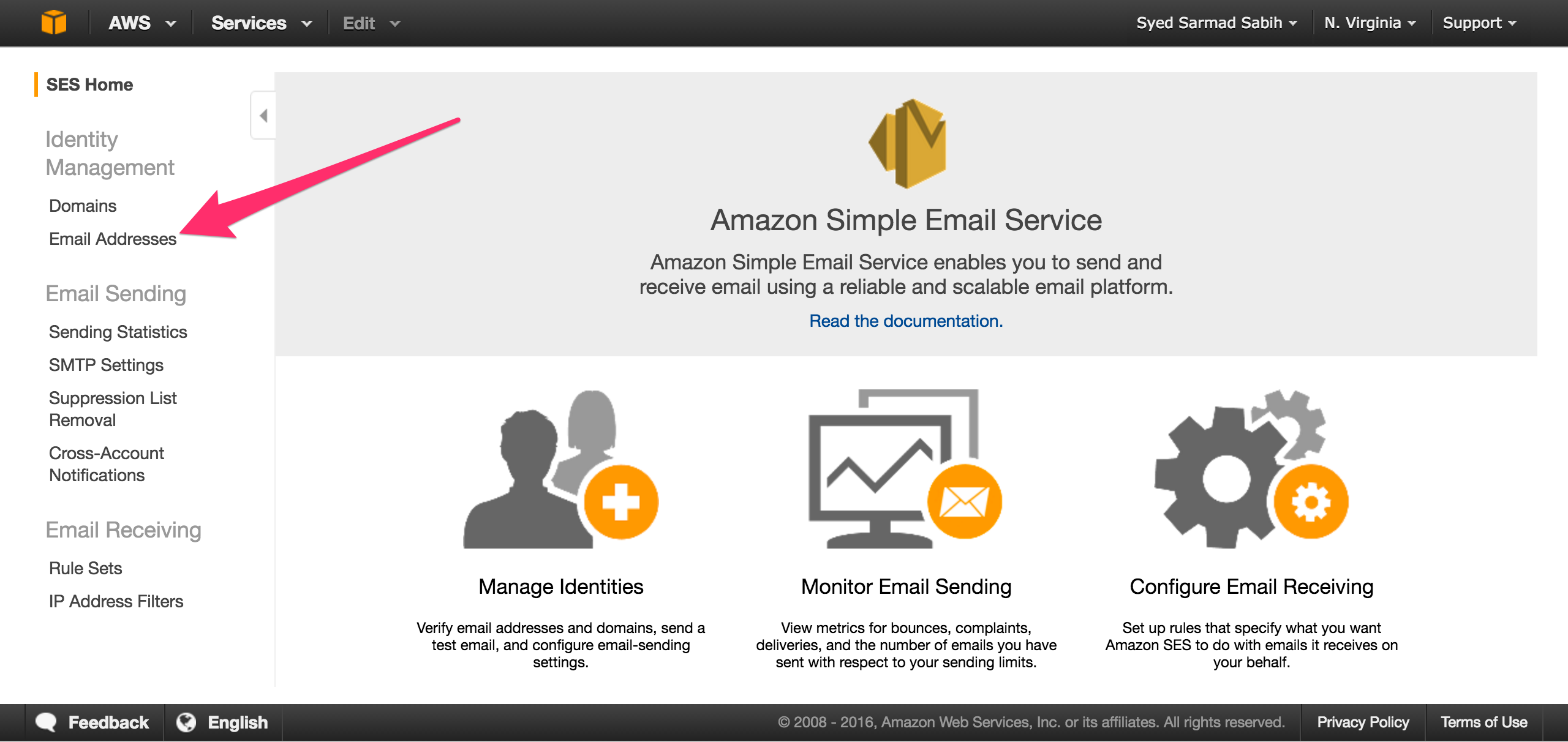
Verify two email addresses (You must have two email addresses to complete the email sending flow in Sandbox mode). I have already added two emails and verified them. Click on Verify a New Email Address button to add your sending and receiving email addresses.
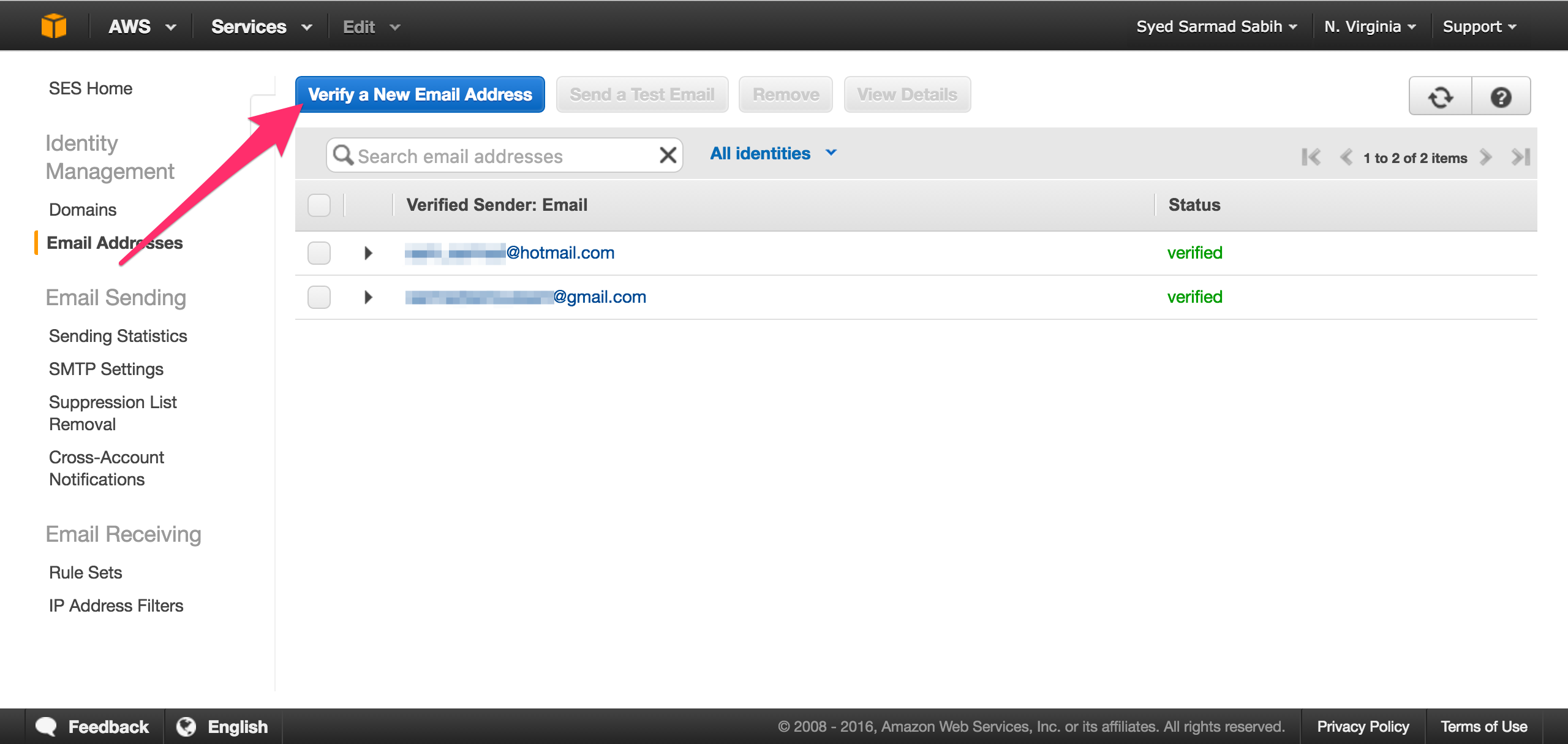
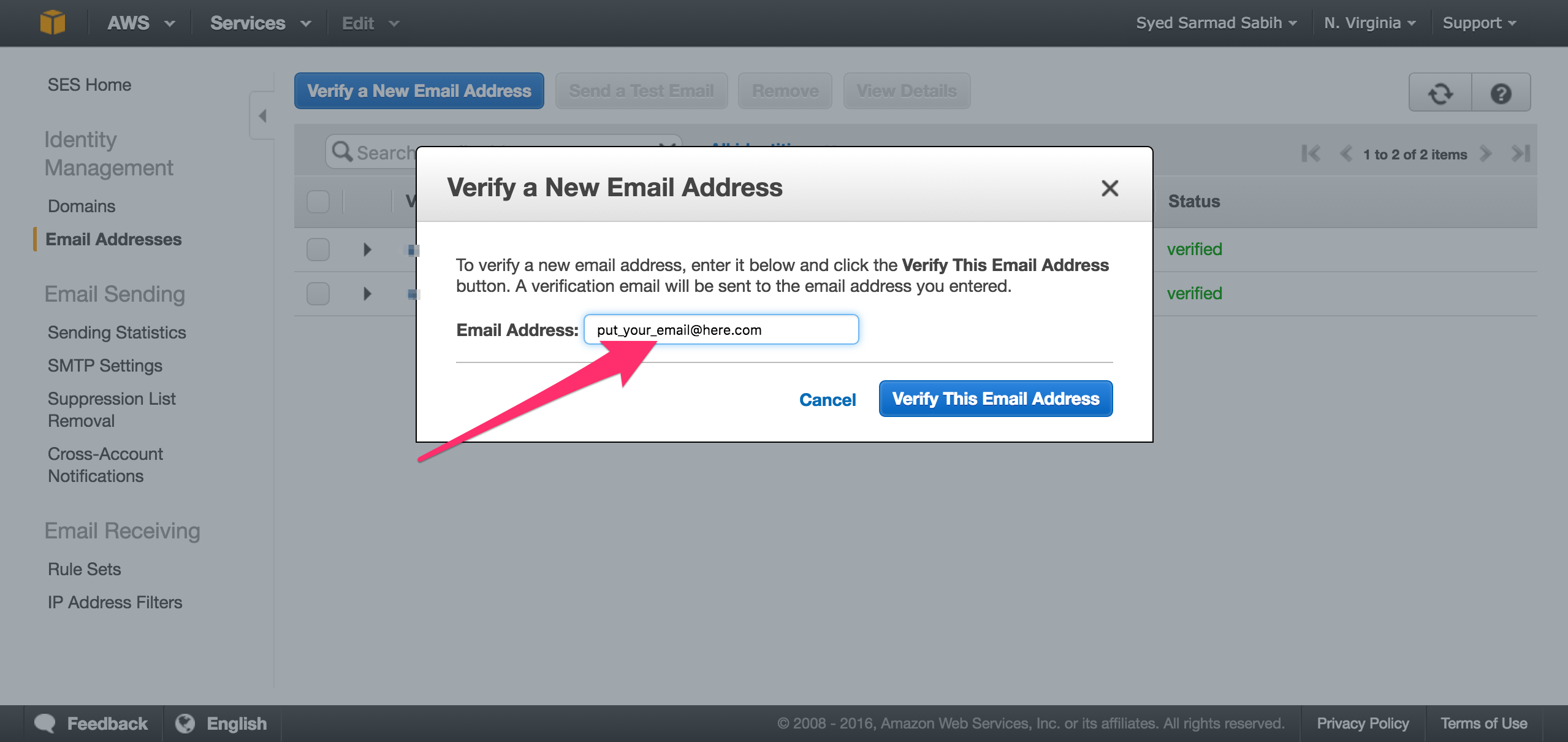
SES will send you a confirmation email, like the one below.
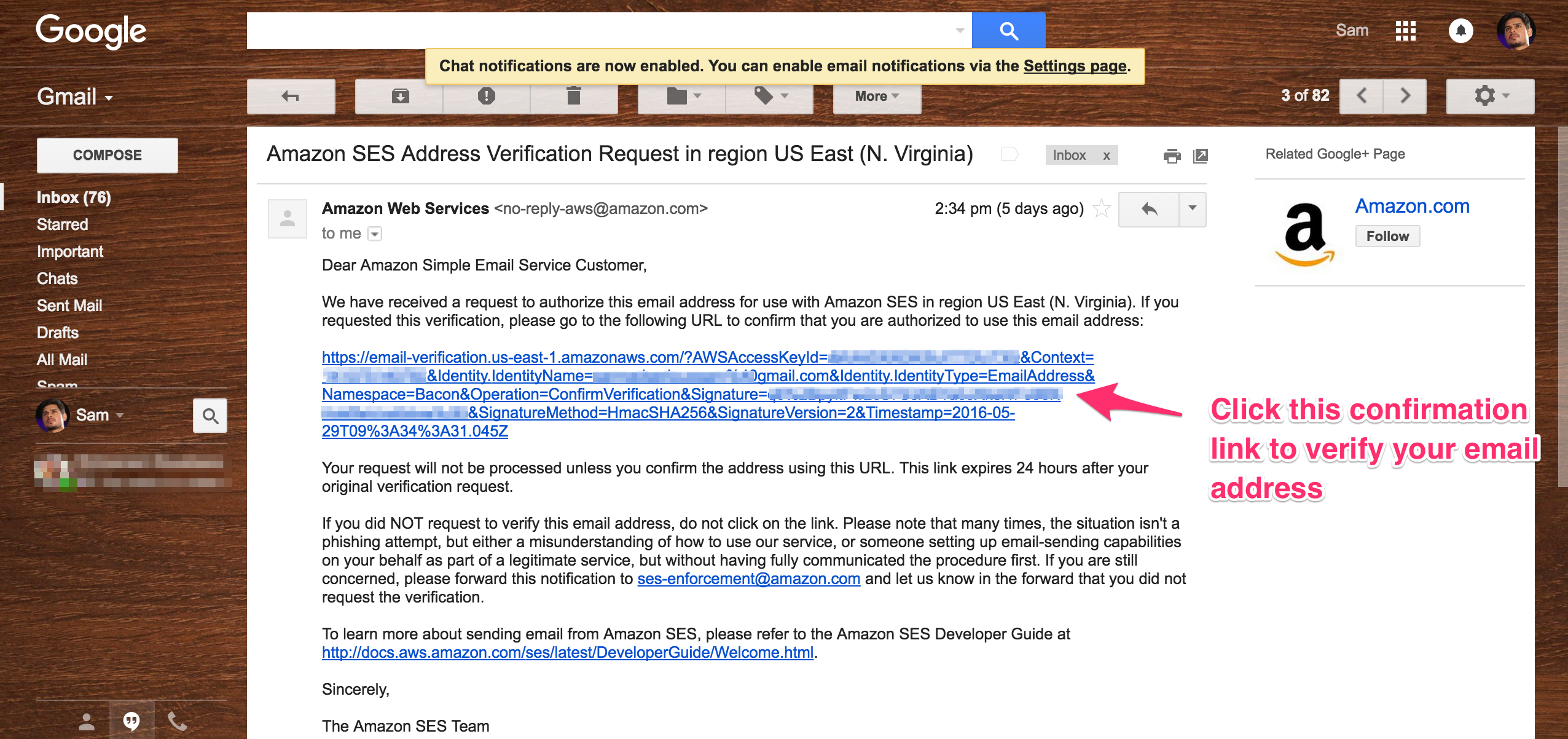
Create your SMTP credentials to use in your app. Copy the SMTP server name to use in your app.
Refreshing the SES Email Adresses page, you should see your email address as verified. Add another one repeating the same steps. Put one email address in app/mailers/application_mailer. rb, replace Some_email@example. com with yours.
And put the other one in app/mailers/my_mailer. rb, replace another_email@example. com with your other verified email address.
Go to the SES SMTP Settings page

Copy the Server Name from there and put it in the action_mailer. smtp_settings block in config/environments/development. rb. Replace this line
With the Server Name you copied from the SMTP Settings page.
Now the action_mailer. smtp_settings block should look similar to this
Click on the “Create My SMTP Credentials” button shown in the picture above.

You can change this username if you want, but this default one will do the trick for now.

Copy these credentials and paste into your config/environments/development. rb or, better yet, export them in your environment:
We are all set to send emails now.

Click Submit. You will see an email sent notice.

Let’s head over to the inbox to verify if the email was properly sent and received.

This sums up this post about setting up our Rails app to send emails with Amazon SES. With this setup and configuration, you can send 62,000 free emails if the app is deployed on Amazon EC2. However, there are some things you must keep a close eye on
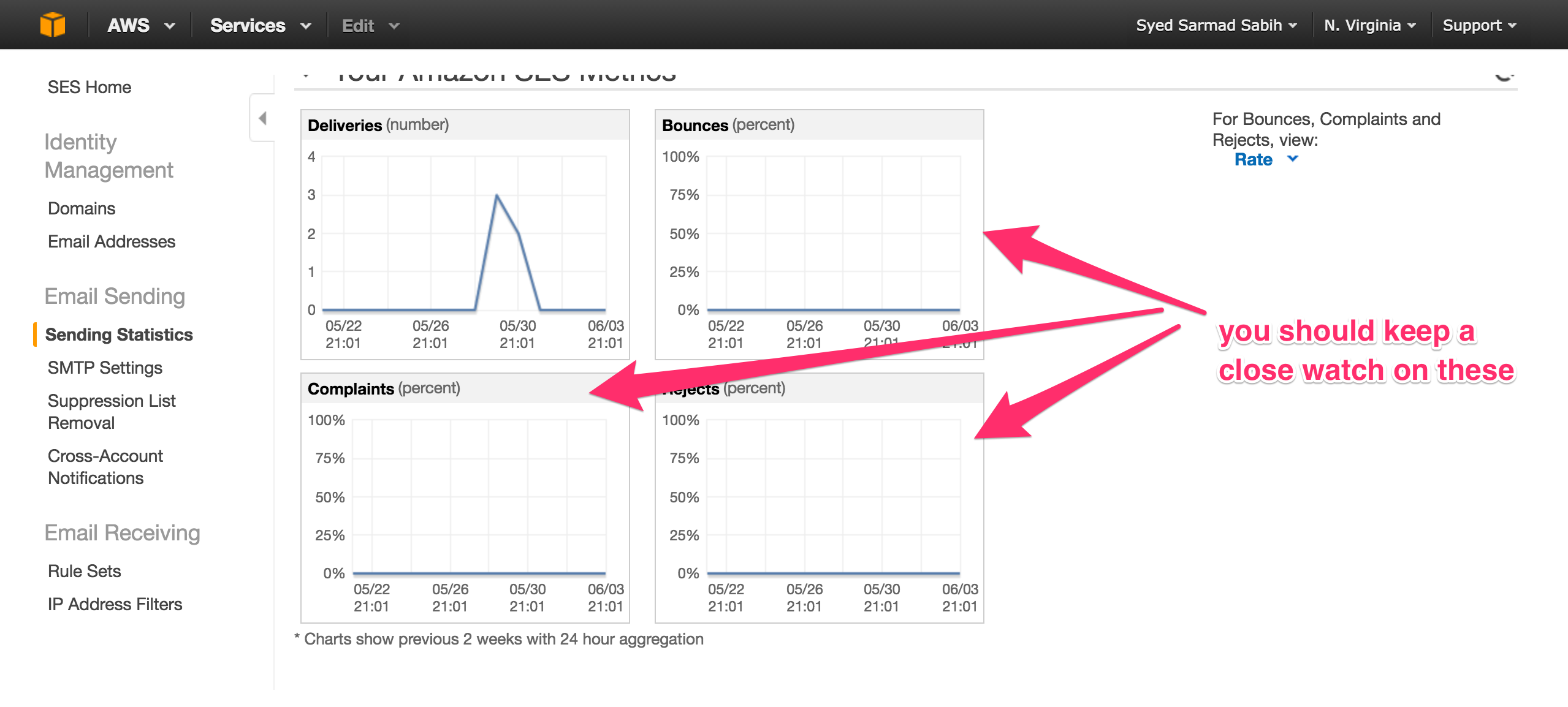
Your Amazon SES account can be blacklisted and blocked if you have a lot of Bounces, Complaints or Rejects. You can read more about it here.
As we discussed that we’re going to be sending emails from Amazon SES Sandbox for this post. You can request Amazon to move you out of the Sandbox from here
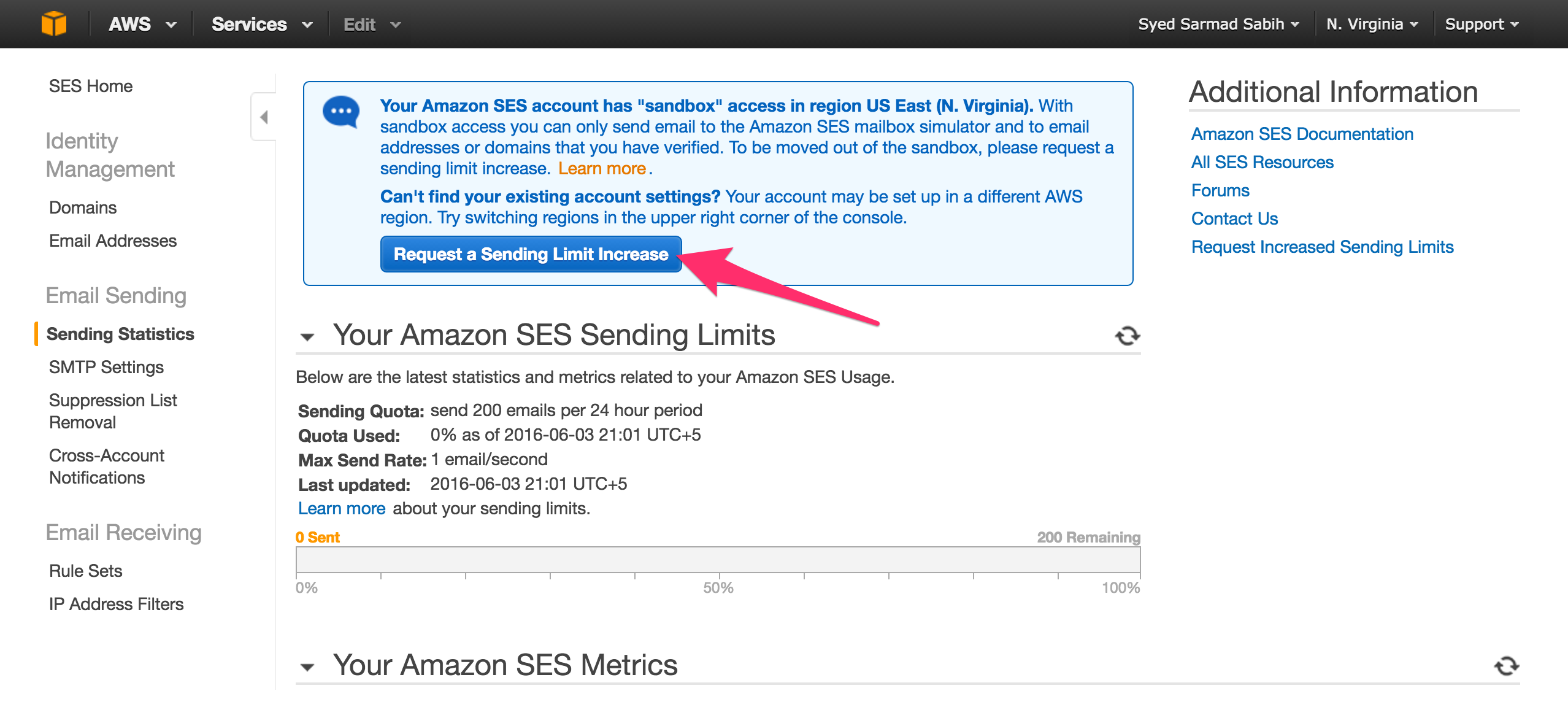
You can read more about that here.
Conclusion
Amazon SES is a great option out there to send easy and inexpensive emails. There are other services as well which might be a better fit than Amazon SES, in some cases, which I’ll hopefully cover in the future.

Комментариев нет